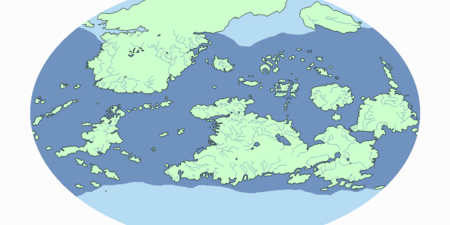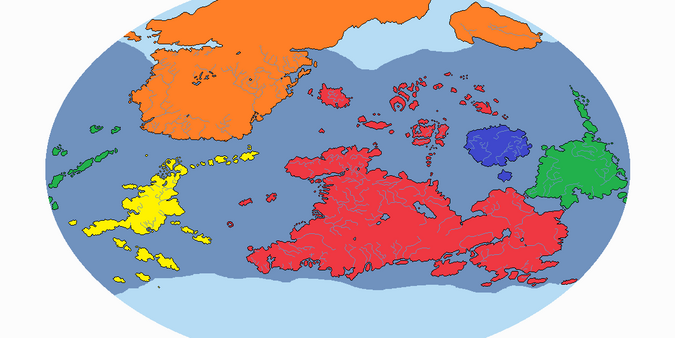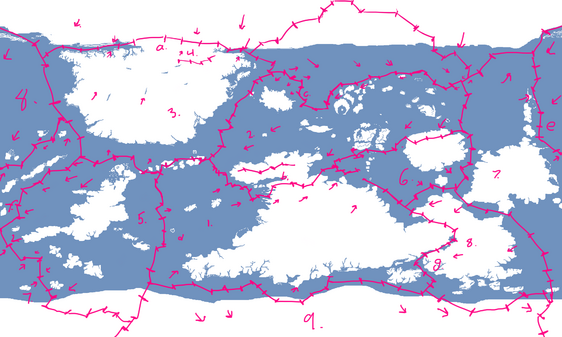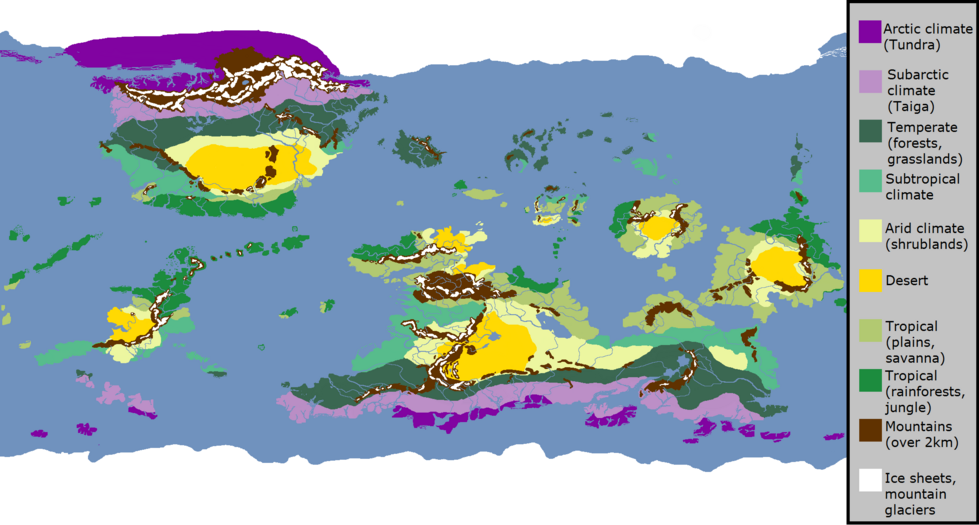Amanir: Difference between revisions
| Line 94: | Line 94: | ||
*'''Old Aydinirian Calendar''', known sometimes also as the '''Imperial Calendar''', was the main Aydinirian calendar before Jashor. History and mythical history was separated into 4 eras or ages, with the Fourth Age being the current one. Years were counted from the traditionally acknowledged date of the Great Exile. According to the Imperial Calendar, Djyazhoar was destroyed in the year 1497 of the Fourth Age. It is sometimes still used for religious liturgy even in the modern day, with years of the Fourth Age counted forward. | *'''Old Aydinirian Calendar''', known sometimes also as the '''Imperial Calendar''', was the main Aydinirian calendar before Jashor. History and mythical history was separated into 4 eras or ages, with the Fourth Age being the current one. Years were counted from the traditionally acknowledged date of the Great Exile. According to the Imperial Calendar, Djyazhoar was destroyed in the year 1497 of the Fourth Age. It is sometimes still used for religious liturgy even in the modern day, with years of the Fourth Age counted forward. | ||
*'''New Aydinirian Calendar''' evolved from the Old Aydinirian Calendar and forms the base for the Standard Calendar. Just like the Imperial Calendar it categorizes both history and mythical history into eras, but adds another, Fifth Age, which is the current one. It starts with Jashor, in the year of the destruction of Djyazhoar, so year 1 of the Fifth Age. Years are counted forward from that event. | *'''New Aydinirian Calendar''' evolved from the Old Aydinirian Calendar and forms the base for the Standard Calendar. Just like the Imperial Calendar it categorizes both history and mythical history into eras, but adds another, Fifth Age, which is the current one. It starts with Jashor, in the year of the destruction of Djyazhoar, so year 1 of the Fifth Age. Years are counted forward from that event. | ||
*'''Reikish Lunisolar Calendar''' is an ancient calendar, with the first references to it being found in stone tablets dating to the 27th Century Before Destruction. As a lunisolar calendar, it provides both the position of the sun and the phase of the Moon on each day. The difference in length between a Lunar Year of 354 days and a Tropical Year of 365 days necessitated some method of correcting for the drift. This led to a 19 year cycle, which entered use around the 6th Century BD. This was followed in the 800s BD by a 76 year cycle, which was more accurate. However, Reikish astronomers would determine that the 76 year cycle was not accurate enough and would develop a new, longer cycle. Initially, this cycle was around 304 years long, proposed shortly after the 76 year cycle. But, by the early Reikish Kingdom in 183 BD, a new cycle had been adopted with added one days to the year every 228 years. This lasted until the early Commonwealth Period in 1166 AD, when a new cycle added two days ever 437 years. With a mere six minute loss every year, an extra day is required every 240 cycles or 104,880 years. | *'''Reikish Lunisolar Calendar''' is an ancient calendar, with the first references to it being found in stone tablets dating to the 27th Century Before Destruction. As a lunisolar calendar, it provides both the position of the sun and the phase of the Moon on each day. The difference in length between a Lunar Year of 354 days and a Tropical Year of 365 days necessitated some method of correcting for the drift. This led to a 19 year cycle, which entered use around the 6th Century BD. This was followed in the 800s BD by a 76 year cycle, which was more accurate. However, Reikish astronomers would determine that the 76 year cycle was not accurate enough and would develop a new, longer cycle. Initially, this cycle was around 304 years long, proposed shortly after the 76 year cycle. But, by the early Reikish Kingdom in 183 BD, a new cycle had been adopted with added one days to the year every 228 years. This lasted until the early Commonwealth Period in 1166 AD, when a new cycle added two days ever 437 years. With a mere six minute loss every year, an extra day is required every 240 cycles or 104,880 years. The Reikish calendar marks the end of the Reikish Return in 1055 BD as Year 1 After Return, with all years before that dated as Before Return. As an example, the formation of the Reikish Kingdom in 872 AR took would be written as 183 BD while the start of the Commonwealth Period, dated as 2195 AR, would be written as 1140 AD. | ||
The Reikish calendar marks the end of the Reikish Return in 1055 BD as Year 1 After Return, with all years before that dated as Before Return. As an example, the formation of the Reikish Kingdom in 872 AR took would be written as 183 BD while the start of the Commonwealth Period, dated as 2195 AR, would be written as 1140 AD. | |||
==Nations== | ==Nations== | ||
Revision as of 00:57, 9 February 2021
 Continents of Amanir | |
| Orbital characteristics | |
|---|---|
| 149598023 km[1] | |
| Eccentricity | 0.0167086 |
| ~365.3 days | |
| Physical characteristics | |
Mean radius | 6371.0 km[2] |
| 510072000 km2[3] | |
| Mass | 5.972 × 10^24 kg |
| 9.81 m/s2 | |
| 40270 km/h[4] | |
| Albedo | 0.367 geometric |
| Atmosphere | |
Surface pressure | 101.325 kPa |
Amanir, sometimes reffered to as simply the world — conworld[5] of the members of the Federation of Allies, a NationStates region. Lorewise, Amanir is a planet located in an unspecified star system and galaxy, possessing extrimely Earth-like qualities, including mass, gravity, size and atmosphere nearly identical to that of Earth, as well as one major moon. Amanir has wide oceans and numerous archipelagos, as well as several major continents. In contrast to Earth however, most of Amanir's landmasses are located on the southern hemisphere.
Amanir as a project combines both a priori and a posteriori elements, meaning that it is a site of both real-life languages or scripts on one side and conlangs[6], as well as constructed religions and scripts, on the other. There is no fantasy races like elves or dwarves however, unless they are purely mythological and appear in beliefs of human nations. Status of magic is as of yet unclear, with some within the region proposing a limited existence of magic and others opposing it all togather.
One of the characteristical features of Amanir is the existence of megafauna and many other relatively recently extinct species.
Name
Etymology
The name Amanir comes from Aydinirian word Amanir [ama'ɲir] and ultimately from Old Aydinirian Amanıer [ama'nʲɛr], meaning "beautiful land". It has deep connections with Jarist cosmogony, as it was supposed to be a descriptive name given by the First Cause to the world upon its creation. In Modern Aydinirian amanir as "world" is often used in poetry.
The planet has also many other names in different languages spoken at its surface.
Names in other languages
| Language | Name |
|---|---|
| Old Aydinirian | Amanıer, Hwéstar /ama'nʲɛr/, /xʷes'tar/ |
| Aydinirian | Awestar, Amanir, Firyaxar[7] /awɛs'tar/, /ama'ɲir/, /firja'ksar/ |
| Saruzh | |
| Üxa | |
| Reikish | Weoertha, translating literally to "Land of Man's Existence" but most commonly translated as "World of Men". |
World
The planet of Amanir is located in the so-called Goldilocks Zone, which makes Earth-like life possible and prevalent. Length of day and year is also extremely similar to that of Earth, planet possesses also a strong magnetosphere. Volcanism is a strong force on Amanir, responsible for creating many volcanic archipelagos and mountain ranges. One of the reasons for that is strong interaction between the tectonic plates and faults.
Geography
The surface of Amanir can be divided into multiple different geographic, historical or cultural regions. The popular and often used method is dividing the planet into five primary continents, with most borders between them formed by oceans and seas. Those continents are: Achara, Gwaii, Ainadestra, Nordenwald and Triuh.
Each of those continents has also other distinct regions. East from the mainland Gwaii lies a big island, called Kilaavik, which is however nearly entirely covered in glaciers. Ainadestra's eastern-most part forms the volcanic Antaran Archipelago. South of Nordenwald lies the island of Faniviace. Imatsshām, a major collection of archipelagos, forms a distinct part of Triuh. Among all of them, the most diverse however is Achara. First of all, two subcontinents are attatched via land to the main body of Achara, Solland in the east and Aydinirian Subcontinent in the north-west. Aydinirian Subcontinent is located mostly on its own tectonic plate, which extends further north, containing many of the northern archipelagos and island chains, including Kïirye, Carinian Archipelago, Grenham Isles and the Twelve Isles. Mainland Achara is often treated as a single continent partly for cultural reasons. Each of those sub-regions is often divided further.
Five major continents of Amanir, although each of them consists also of other smaller regions and subcontinents.
Red: Achara, orange: Gwaii, yellow: Ainadestra, blue: Nordenwald, green: Triuh.
Climate
Large swaths of temperate climate forests and grasslands exist on Amanir, mostly on central-northern Gwaii and southern Achara, but there are also areas where ice bounds enormous territories, mostly in Gwaii and Kilaavik, but also in some southern-most parts of Achara and Ainadestra. Deserts form in the interiors of all continents, but also in other places, like eastern parts of the Aydinirian Subcontinent or southern islands of the Carinian Archipelago. The greatest deserts can be found on Achara and Gwaii and that's where the highest temperatures of the planet can be observed. Other parts of the world enjoy mostly tropical or subtropical climate, eased further by close distance to the ocean.
Several inland seas and major lakes can be found on Achara. Some of them are a result of high tectonic activity on the border between Achara Proper and Solland, others however are the remains of ancient oceans, like the Jalumyyrian Sea, located at the borders of Norcourt.
Some parts of Amanir are extremely mountainous, which allows the formation of mountain glaciers even in equatorial or near-equatorial areas. The highest mountain chains are located mostly on Achara, Ainadestra and Gwaii.
Fauna and flora
description of flora, fauna and our odd megafauna, where what
Calendar
So called Standard Calendar counts years with Jashor, meaning the Fall of [Old] Aydinirian Empire, as the point of reference. Year of the destruction of the city of Djyazhoar, empire's capital, marks year 1 AD (After Destruction), alternatively 1 AJ or 1 AC (After Jashor or After Collapse). Events and years that occured before the destruction of Djyazhoar are reffered to as BD (Before Destruction), alternatively BJ or BC (Before Jashor or Before Collapse).
Other methods of counting years are or were also in use throught Amanir. Some of them include:
- Old Aydinirian Calendar, known sometimes also as the Imperial Calendar, was the main Aydinirian calendar before Jashor. History and mythical history was separated into 4 eras or ages, with the Fourth Age being the current one. Years were counted from the traditionally acknowledged date of the Great Exile. According to the Imperial Calendar, Djyazhoar was destroyed in the year 1497 of the Fourth Age. It is sometimes still used for religious liturgy even in the modern day, with years of the Fourth Age counted forward.
- New Aydinirian Calendar evolved from the Old Aydinirian Calendar and forms the base for the Standard Calendar. Just like the Imperial Calendar it categorizes both history and mythical history into eras, but adds another, Fifth Age, which is the current one. It starts with Jashor, in the year of the destruction of Djyazhoar, so year 1 of the Fifth Age. Years are counted forward from that event.
- Reikish Lunisolar Calendar is an ancient calendar, with the first references to it being found in stone tablets dating to the 27th Century Before Destruction. As a lunisolar calendar, it provides both the position of the sun and the phase of the Moon on each day. The difference in length between a Lunar Year of 354 days and a Tropical Year of 365 days necessitated some method of correcting for the drift. This led to a 19 year cycle, which entered use around the 6th Century BD. This was followed in the 800s BD by a 76 year cycle, which was more accurate. However, Reikish astronomers would determine that the 76 year cycle was not accurate enough and would develop a new, longer cycle. Initially, this cycle was around 304 years long, proposed shortly after the 76 year cycle. But, by the early Reikish Kingdom in 183 BD, a new cycle had been adopted with added one days to the year every 228 years. This lasted until the early Commonwealth Period in 1166 AD, when a new cycle added two days ever 437 years. With a mere six minute loss every year, an extra day is required every 240 cycles or 104,880 years. The Reikish calendar marks the end of the Reikish Return in 1055 BD as Year 1 After Return, with all years before that dated as Before Return. As an example, the formation of the Reikish Kingdom in 872 AR took would be written as 183 BD while the start of the Commonwealth Period, dated as 2195 AR, would be written as 1140 AD.



